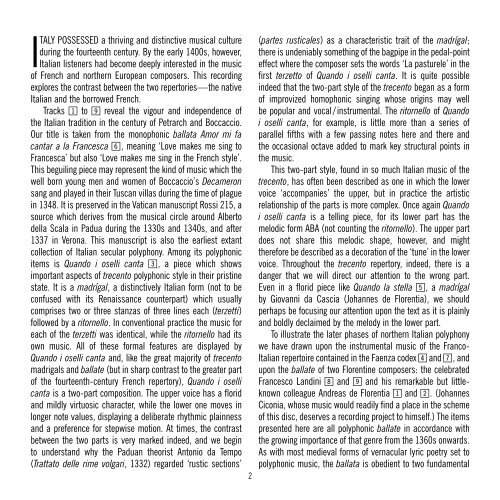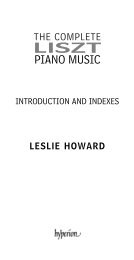application/pdf : 241 Ko - Abeille Musique
application/pdf : 241 Ko - Abeille Musique
application/pdf : 241 Ko - Abeille Musique
Create successful ePaper yourself
Turn your PDF publications into a flip-book with our unique Google optimized e-Paper software.
I<br />
TALY POSSESSED a thriving and distinctive musical culture<br />
during the fourteenth century. By the early 1400s, however,<br />
Italian listeners had become deeply interested in the music<br />
of French and northern European composers. This recording<br />
explores the contrast between the two repertories—the native<br />
Italian and the borrowed French.<br />
Tracks 1 to 9 reveal the vigour and independence of<br />
the Italian tradition in the century of Petrarch and Boccaccio.<br />
Our title is taken from the monophonic ballata Amor mi fa<br />
cantar a la Francesca 6, meaning ‘Love makes me sing to<br />
Francesca’ but also ‘Love makes me sing in the French style’.<br />
This beguiling piece may represent the kind of music which the<br />
well born young men and women of Boccaccio’s Decameron<br />
sang and played in their Tuscan villas during the time of plague<br />
in 1348. It is preserved in the Vatican manuscript Rossi 215, a<br />
source which derives from the musical circle around Alberto<br />
della Scala in Padua during the 1330s and 1340s, and after<br />
1337 in Verona. This manuscript is also the earliest extant<br />
collection of Italian secular polyphony. Among its polyphonic<br />
items is Quando i oselli canta 3, a piece which shows<br />
important aspects of trecento polyphonic style in their pristine<br />
state. It is a madrígal, a distinctively Italian form (not to be<br />
confused with its Renaissance counterpart) which usually<br />
comprises two or three stanzas of three lines each (terzetti)<br />
followed by a ritornello. In conventional practice the music for<br />
each of the terzetti was identical, while the ritornello had its<br />
own music. All of these formal features are displayed by<br />
Quando i oselli canta and, like the great majority of trecento<br />
madrigals and ballate (but in sharp contrast to the greater part<br />
of the fourteenth-century French repertory), Quando i oselli<br />
canta is a two-part composition. The upper voice has a florid<br />
and mildly virtuosic character, while the lower one moves in<br />
longer note values, displaying a deliberate rhythmic plainness<br />
and a preference for stepwise motion. At times, the contrast<br />
between the two parts is very marked indeed, and we begin<br />
to understand why the Paduan theorist Antonio da Tempo<br />
(Trattato delle rime volgari, 1332) regarded ‘rustic sections’<br />
(partes rusticales) as a characteristic trait of the madrígal;<br />
there is undeniably something of the bagpipe in the pedal-point<br />
effect where the composer sets the words ‘La pasturele’ in the<br />
first terzetto of Quando i oselli canta. It is quite possible<br />
indeed that the two-part style of the trecento began as a form<br />
of improvized homophonic singing whose origins may well<br />
be popular and vocal / instrumental. The ritornello of Quando<br />
i oselli canta, for example, is little more than a series of<br />
parallel fifths with a few passing notes here and there and<br />
the occasional octave added to mark key structural points in<br />
the music.<br />
This two-part style, found in so much Italian music of the<br />
trecento, has often been described as one in which the lower<br />
voice ‘accompanies’ the upper, but in practice the artistic<br />
relationship of the parts is more complex. Once again Quando<br />
i oselli canta is a telling piece, for its lower part has the<br />
melodic form ABA (not counting the ritornello). The upper part<br />
does not share this melodic shape, however, and might<br />
therefore be described as a decoration of the ‘tune’ in the lower<br />
voice. Throughout the trecento repertory, indeed, there is a<br />
danger that we will direct our attention to the wrong part.<br />
Even in a florid piece like Quando la stella 5, a madrígal<br />
by Giovanni da Cascia (Johannes de Florentia), we should<br />
perhaps be focusing our attention upon the text as it is plainly<br />
and boldly declaimed by the melody in the lower part.<br />
To illustrate the later phases of northern Italian polyphony<br />
we have drawn upon the instrumental music of the Franco-<br />
Italian repertoire contained in the Faenza codex 4 and 7, and<br />
upon the ballate of two Florentine composers: the celebrated<br />
Francesco Landini 8 and 9 and his remarkable but littleknown<br />
colleague Andreas de Florentia 1 and 2. (Johannes<br />
Ciconia, whose music would readily find a place in the scheme<br />
of this disc, deserves a recording project to himself.) The items<br />
presented here are all polyphonic ballate in accordance with<br />
the growing importance of that genre from the 1360s onwards.<br />
As with most medieval forms of vernacular lyric poetry set to<br />
polyphonic music, the ballata is obedient to two fundamental<br />
2

















